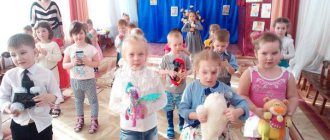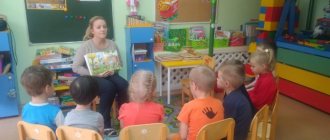The importance of fine arts for children 4–5 years old
Many great philosophers and teachers of the past highly valued the importance of drawing in raising children. Thus, the ancient Greek philosopher Aristotle attached great importance to subjects of the aesthetic cycle (music, drawing) in the development of a child. He emphasized that drawing is studied because it develops the eye in determining physical beauty.
What is fine art
Fine arts are not only aimed at completing educational tasks. This term is associated with the all-round development of a child at the age of 4-5 years. The guys begin to draw interesting images, assemble designs, and make appliqués. All these actions contribute to the mental and moral education of the child. As a rule, the baby develops during the learning process. First of all, he must create an expressive image for himself, as well as master the techniques of depiction.
Conducting an educational activity on drawing on a chosen topic (suitable topics for children 4–5 years old)
The availability of using non-traditional techniques is determined by the age characteristics of preschoolers. So, for example, you should start working in this direction with techniques such as drawing with your fingers, palm, tearing paper, etc., but in older preschool age these same techniques will complement the artistic image created using more complex ones: blotography, monotype. Here are several ways of drawing using non-traditional techniques.
How is GCD for drawing on a chosen topic carried out?
- Theme: “Autumn”
During the lesson you need to make prints of leaves and use gouache. This unconventional method teaches you to mix red and yellow gouache to create an orange color, and also to distinguish which tree is depicted on paper.
Didactic game with environmental content for preschoolers
The following material is used for work: landscape sheet, fallen leaves from different trees (maple, birch, rowan, poplar, oak), gouache, wide brush, container with water, sheet of paper or oilcloth (place under the leaves to be painted).
During class, the teacher asks the children what leaves fall out. Then each child takes one leaf, places it with the smooth side on the oilcloth and paints the underside of the leaf with gouache of the same color. To get an orange leaf print, you need to teach children to mix red and yellow paints. While the gouache has not dried, the painted side of the leaf is applied to a clean sheet of paper and pressed tightly so that it is printed in its entirety. The leaf cannot be moved.
- The next topic of the week is “Dishes”
Drawing is done with cotton swabs. The teacher teaches children to draw a piece of utensils. A simple pencil is used for this. Children can independently select suitable colors and trace the outline with dots using a cotton swab with gouache.
For the lesson you need the following items: cup, plate, pan, ball, album sheets, simple pencils, cotton swabs, gouache, jars of water (for each child).
A selection of demonstration materials for the conversation (photos and drawings)
Before depicting a fictional character or object on paper, the teacher conducts a conversation with the children. The guys carefully look at the illustrations, study pictures with images that are interesting to them. The teacher places bright cardboard cards on the table on various topics, for example, “Spring”, “My City”, “New Year”, “Winter”, “Airplane”, “Where the birds fly for the winter”, “Snowman”, “Girl and Boy” ", "Winter Garden".
Music and poetry appropriate to the topic of the lesson
Drawing in the middle group is accompanied by cheerful melodies and poems. To begin with, the teacher prepares musical material:
- "Polyanka" - Russian folk music;
- “Lullaby” - A. Grechaninov;
- The play “Three Girlfriends” - D. Kabalevsky;
- Song “Winter” - M. Kartushina;
- Song “Two windows from the yard and a spreading maple”;
- Song “Sun through the leaves”;
- The game “It’s so cold, it’s frosty” is a Russian folk melody, arranged by I. Ponomareva.
Note! Before completing the work, the children begin to dance to the rhythm of the music. They must convey the mood of this composition in their movements.
Summary of a lesson on drawing in the chosen technique in the middle group (fragment in the form of a table)
| Topic of the week | Lesson notes | Material and method of conveying the idea |
| Body and face numbers | There are such boys | Drawing with a simple pencil |
| Vegetables | Cucumber tomato | Drawing with colored pencils |
| Fruits | Apple/pear | Brush, gouache |
| Berries | Cherry branch | Colour pencils |
| Birds | Dymkovo birds | Brush, gouache (team work) |
| Autumn | Autumn leaves | Fingerprints (gouache) |
| Pets | Kitty | Poking with a hard semi-dry brush (gouache) |
Examples of finished works, photo gallery
Here are several finished works with topics interesting for kids:
- "Winter Fun"
Children learn to convey the features of the depicted object using an imprint with crumpled paper. The guys draw the desired image (Snow Maiden) using a brush. As a material, you can use blue cardboard, a container with white gouache, slightly diluted with water, medium-sized lumps of crumpled paper, gouache, brushes, jars of water.
Examples of work with photography
The teacher invites the children to draw a friend for the snow woman in an unusual way - with crumpled paper.
Next, the teacher shows how crumpled paper is lowered into a saucer with white paint and placed several times at the bottom of the cardboard, depicting a round ball. Then draw a small ball in the same way. When the paint dries, you need to finish painting the snow woman’s eyes, carrot nose, and twig hands.
- "Defender of the Fatherland Day»
The guys create a drawing for the holiday using a brush on a wet sheet of paper. Next comes an introduction to a new technique of drawing on a damp sheet of paper. They choose a beautiful paint color to create the desired look. The materials used are paper, watercolors, a brush, a container of water, and napkins.
The teacher invites the children to draw fireworks in honor of the holiday. First, you need to apply water to the landscape sheet with a wide brush. Then put watercolor paint on a thin brush and touch it to a sheet of paper in several places. The dots will begin to spread out. The empty spaces need to be filled with spreading dots of other colors.
Theatrical performances and dramatizations of fairy tales in senior groups
Note! Make sure that children rinse the brush thoroughly in water.
Step-by-step instructions for drawing the selected plot
- The name of the topic and step-by-step instructions for drawing the selected plot - “Migratory and sedentary birds”
The lesson in the middle group is carried out using colored pencils. The child will learn how to draw a bird using an oval and a circle. Initially, children get acquainted with the distinctive features of an owl, which contributes to the development of imagination.
Instructions on how to correctly depict the selected plot
The material used is a subject picture depicting an owl; halves of album sheets, simple and colored pencils.
"It's dark in the forest,
Everyone has been sleeping for a long time.
One owl doesn't sleep
Sits on a branch
Looks in all directions
How it will fly!”
Note! You should look at and study the image of an owl with your children. The teacher should tell that an owl is a large bird with huge eyes. At night she hunts mice and during the day she sleeps.
Next, the guys will start doing the work. To do this, you need to draw a circle (head) with a simple pencil, and draw an oval at the bottom, narrowed downwards. On the head draw large eyes, a beak, and ears. At the bottom of the oval are the paws and the branch on which the owl is sitting. When the owl is ready, you need to paint it over with an orange, yellow or brown pencil.
Drawing technique in the middle group according to the Federal State Educational Standard
Through lightness, airiness or softness and smoothness, sharpness and aggressiveness, you can tell about the character of the hero, his attitude to the world around him. Pencil, sanguine, charcoal, pastel, ink are excellent means for expressing your vision of the beauty of the world around you.
Drawing in the middle group according to the Federal State Educational Standard helps the child relieve stress. Classes are organized as a game of transformation, where a child and an adult become either actors or spectators. To make artistic activities accessible to every child, it is necessary to use movements, music, sounds, and touch.
Important! High-quality lesson planning will lead to the establishment of emotional contacts between children, between adults and children.
Options for individual and collective drawings in different techniques (including non-traditional)
The development of the creative abilities of preschool children with the creation of individual or collective drawings is aimed at introducing non-traditional types of visual techniques (“finger painting”, “palm painting”, “poking with a hard semi-dry brush”, “printing”, “drawing on semolina or sand”, etc. .).

